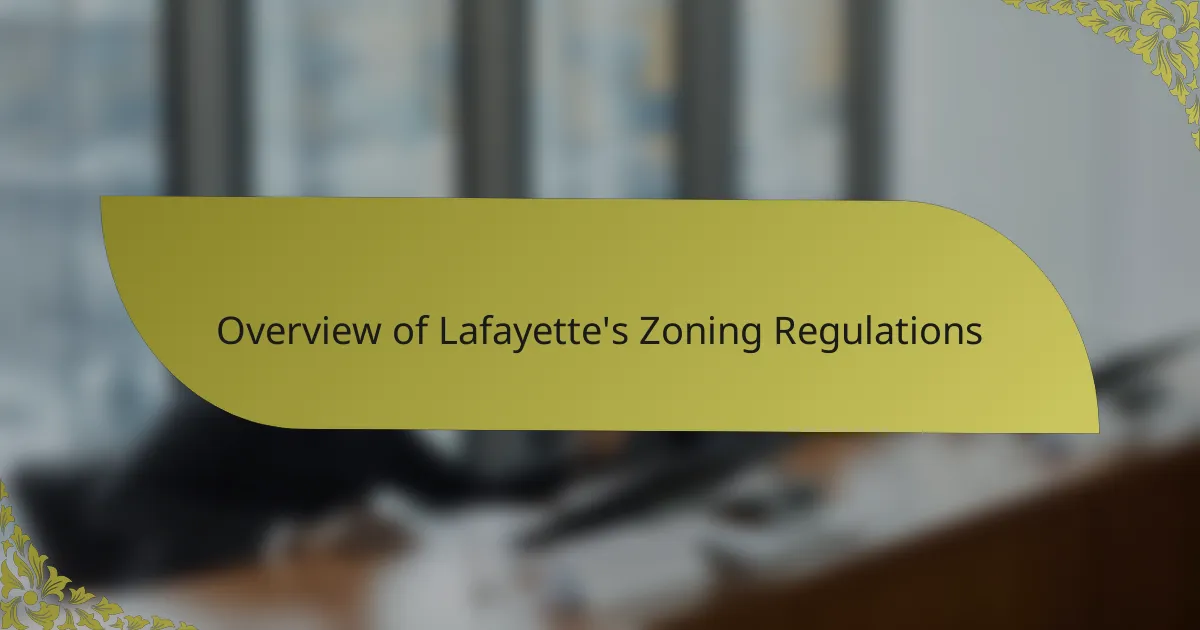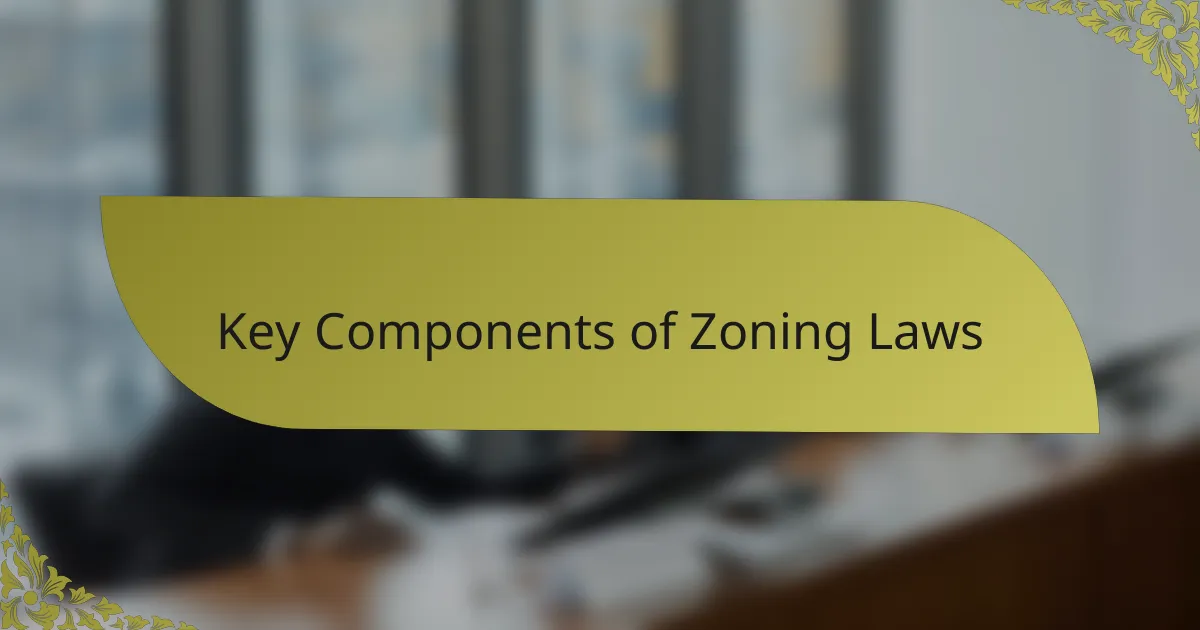Key takeaways
- Understanding zoning laws is crucial for shaping community development, protecting property values, and promoting orderly land use.
- Lafayette’s zoning regulations emphasize public involvement, allowing residents to influence decisions impacting their neighborhoods.
- Key components of zoning laws include land use categories, building setbacks, height restrictions, and variance procedures.
- Engaging with local officials and networking with community members can ease the zoning application process and enhance advocacy efforts.

Understanding Louisiana Zoning Laws
Understanding Louisiana zoning laws can feel quite daunting, but I’ve come to appreciate their purpose. They essentially dictate how land can be used—residential, commercial, industrial—and they often aim to promote orderly development within communities. Have you ever stood in a neighborhood and wondered why some areas feel bustling and commercial, while others are calm and residential? That’s the zoning at work!
From my experience, certain zoning regulations can surprise you. For example, I once looked into starting a small business in my neighborhood and discovered that my property was zoned residential only. It was a revelation to me about how zoning laws can directly affect not just business opportunities, but the character of a community. These laws aren’t just bureaucratic jargon; they shape our everyday environments.
Moreover, the zoning process in Louisiana is often intertwined with local governance. I’ve attended a few city council meetings where these laws were discussed, and it’s fascinating to see residents passionately advocating for changes. It made me realize that zoning isn’t static—it evolves with community needs and desires. How often do we think about the impact of our voice in these discussions? Understanding zoning laws means embracing our role in shaping the places we call home.

Importance of Zoning in Government
Zoning is fundamental in government because it serves as a framework for community development. Without it, cities could become chaotic, with industrial sites popping up next to residential homes. I can recall walking through a neighborhood where a factory suddenly replaced charming houses; it made me appreciate how vital zoning is in maintaining the character of our communities.
Moreover, zoning laws help protect property values and ensure that neighborhoods remain cohesive and functional. For example, my friend once bought a lovely home in an area zoned for single-family residences. When a mixed-use development was proposed nearby, she raised concerns at a council meeting, demonstrating how residents can directly influence zoning decisions. Isn’t it empowering to know that your voice can protect the value of your home?
Additionally, zoning can drive economic development. I remember hearing a local leader discuss how strategic zoning could attract businesses and investment to our area. This proactive approach not only creates jobs but also enhances community services and amenities. It’s amazing how thoughtful zoning can lead to vibrant, thriving neighborhoods, isn’t it?

Overview of Lafayette’s Zoning Regulations
Lafayette’s zoning regulations are designed to create a balanced environment for its residents while promoting responsible development. From what I’ve observed, these regulations categorize land use into various districts, clearly defining where homes, stores, and other facilities can be established. This clarity can be a bit comforting, knowing there’s a plan in place to maintain the character of different areas.
One interesting aspect of Lafayette’s zoning is the mixed-use developments allowed in certain zones. I remember attending a community meeting where a proposal for a mixed-use space was discussed. It excited many residents but also raised concerns about increased traffic and noise. This highlights how zoning laws directly influence not just the layout of our city, but also our daily lives. Have you ever wondered how those decisions might affect your neighborhood’s charm?
I also find it noteworthy that Lafayette strives to welcome public input on zoning regulations. When I shared my thoughts about a new development proposal, I felt heard and valued, which reinforces the idea that zoning isn’t solely dictated by officials. It’s dynamic and responsive to community needs. I left that meeting feeling energized, knowing we all have a stake in the zoning process that shapes Lafayette’s future.

Key Components of Zoning Laws
When I first delved into Lafayette’s zoning laws, I was struck by how they shape the community’s character and functionality. It’s not just about land use; it’s about ensuring that different areas serve their intended purposes while accommodating growth and protecting residents’ quality of life. I remember walking through a neighborhood that perfectly illustrated this balance, where homes, parks, and businesses coexisted harmoniously.
The key components that define Lafayette’s zoning laws include:
- Land Use Categories: Different designations for residential, commercial, industrial, and mixed-use developments.
- Building Setbacks: Regulations dictating how far structures must be from property lines, which maintain aesthetics and safety.
- Height Restrictions: Limits on building heights to ensure views aren’t obstructed and the skyline remains consistent.
- Zoning Permits: Requirements for obtaining approvals before construction or significant alterations can begin.
- Variance Procedures: Allowing property owners to request exceptions to zoning regulations under specific circumstances.
Understanding these components was eye-opening for me; they really influence not just how a city grows but also how its residents live day to day.

Personal Experience with Zoning Applications
Navigating the zoning application process in Lafayette was more than just filling out forms for me; it felt like stepping into a complex maze. I remember when I applied for a permit to turn a part of my property into a community garden. The excitement quickly turned into anxiety as I dove into the zoning laws, trying to ensure that I met all the regulations. The feeling of uncertainty was palpable, but I found comfort in the support of local forums where others shared their own challenges.
Through this experience, I learned a few valuable lessons that I think can be helpful for anyone looking to embark on a similar journey:
- Understand the zoning categories: Familiarizing myself with how different areas were designated (residential, commercial, etc.) made all the difference.
- Consult with local officials: They can provide guidance that isn’t always clear in the paperwork.
- Seek advice from community members: Engaging with locals who’ve traversed the same path was invaluable and often provided insider tips.
- Be prepared for delays: Patience is key; the review process can take longer than expected.
- Document everything: Keeping meticulous records helped streamline any follow-up questions from the zoning department.
This process, while daunting, ultimately pushed me to advocate for my vision and connect with my community in a meaningful way.

Tips for Navigating Local Zoning
Understanding how to navigate local zoning laws can truly empower you in your community. When I first dipped my toes into this process, I was overwhelmed by the variety of regulations and guidelines. It helped to create a checklist of key points to review before submitting any applications. This way, I could ensure I wasn’t missing anything crucial. Have you ever encountered a detail in red tape that completely changed your approach? It’s frustrating, but staying organized makes the journey much smoother.
I also found that attending local meetings was one of the best tips I could share. Hearing firsthand about upcoming zoning changes and proposals was invaluable. Some of the most compelling insights came not just from officials, but from residents sharing their stories. Isn’t it refreshing to hear from your neighbors? It reminds me that we all have a stake in shaping our environment, and being part of that conversation can bring a sense of connection to your community.
Lastly, never underestimate the power of networking. When I was navigating my zoning application, I reached out to local business owners who had been through the process. Their experiences were filled with practical advice and emotional support. It felt like having a mentor guiding me through the maze. Don’t you think it makes a world of difference to know you’re not alone? Building those relationships can turn a complicated process into a collaborative adventure.

Resources for Further Zoning Education
When it comes to understanding Lafayette’s zoning laws, there is a wealth of resources available to help deepen your knowledge. I often recommend starting with the City of Lafayette’s official website, where you can find a detailed zoning map and specific regulations. Personally, I found the community workshops incredibly beneficial for engaging with the material and connecting with local experts.
Another valuable resource is the Louisiana State University’s Cooperative Extension Service, which provides educational programs that can clarify zoning laws and their implications. These sessions often share real-life scenarios that illustrate how zoning affects residents’ everyday lives, making the information much more relatable.
If you’re looking for a way to visualize the differences in zoning classifications, check out the comparison table below. It can be a handy reference as you navigate through the complexities of zoning terminology and regulations.
| Zoning Type | Description |
|---|---|
| Residential | Areas primarily for housing, including single-family homes, apartments, and townhouses. |
| Commercial | Designated for retail businesses, offices, and service establishments. |
| Industrial | Zones for manufacturing, warehousing, and similar uses that may generate noise or traffic. |